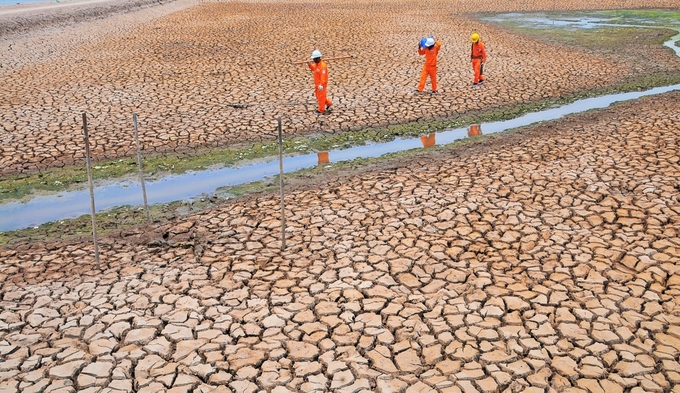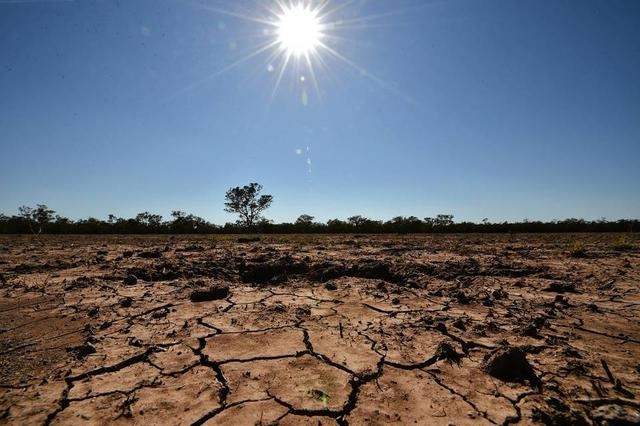November 27, 2025 | 13:33 GMT +7
November 27, 2025 | 13:33 GMT +7
Hotline: 0913.378.918
November 27, 2025 | 13:33 GMT +7
Hotline: 0913.378.918
The National Centre for Hydro - Meteorological Forecasting expects that El Nino will begin in late May or early June 2023 with a probability of 70-80%, and may last until early 2024. El Nino often causes a shortage of rainfall in most regions across the country, with a loss between 25 and 50%.

El Nino has had significant impacts on the drought and saltwater intrusion in 2023.
Several meteorological organizations around the world, including World Meteorological Organization (WMO), National Oceanic and Atmospheric Administration (NOAA), Japan Meteorological Agency (JMA), have forecast El Nino to begin from the middle of this year. NOAA believes that there is a 90% chance that El Nino will last until next year in the northern hemisphere.
Accordingly, Prime Minister Pham Minh Chinh issued Official Dispatch No. 397/CD-TTg dated May 13, 2023 on urgent measures to respond to the risk of extreme heat, drought, water shortage, and saltwater intrusion. Subsequently, the Ministry of Agriculture and Rural Development directed various local People's Committees to organize solutions in response to the risk of drought, water shortage, and saltwater intrusion in accordance with this Official Dispatch.
The Ministry of Agriculture and Rural Development proposed local governments to develop an overall plan to prevent and combat drought, water shortage and saltwater intrusion from 2023 to 2025. The Ministry also recommended local governments develop solutions to various meteorological, hydrological, and water-related issues caused by El Nino.
Local governments must regularly monitor and update information on meteorological and hydrological forecasts; provide forecasts on water sources and develop water use plans in river basins prior to the production season/month/week to control the water supply for local people.
Stakeholders are encouraged to periodically inventory and monitor the quantity, quality of water sources in irrigation or rural domestic water supply works. Moreover, detailed water distribution plans for different periods are required throughout the year. In the event of water shortage, appropriate adjustments must be made with priorities given to necessities such as daily living, industrial production, livestock, annual and perennial crops, etc. On the other hand, local governments need to closely monitor the regulation cycle of water reservoirs to avoid concentrated regulation that can lead to water shortage later in the cycle.

According to various forecasts, the heat and drought will be more severe compared to previous years.
Various preventative measures have been implemented across the country including: estuary dredging for water; construction of temporary dams to prevent saltwater intrusion; freshwater storage in the canal system; water storage pond digging; well drilling; installation and operation of field pumping stations to utilize the water from rivers and streams, reservoirs' dead storage capacity and in-field regressed water sources.
Local governments need to organize their agricultural production structure in accordance with the water source capacity. Namely, the sowing schedule must be adjusted in areas at risk of irrigation water shortage to avoid drought and seawater intrusion occurring during the crops' sensitive growing stage.
On the other hand, local farmers are instructed to gradually convert from rice to crops that require less water for irrigation and meet market demands, with a focus on quality over quantity in production. In order to improve water distribution and regulation, farmers are also advised to plan production areas for crops with comparable tolerance to drought, salt, and water demand.
Regarding long-term crops with high economic value, it is important to encourage the adoption of modern agricultural methods as well as new pest- and disease-resistant cultivars that can withstand drought, water scarcity, and saltwater intrusion.
Local governments should prioritize irrigation water during the crops' water-sensitive seasons, especially for fruits and vegetables with high economic value. They should also encourage the deployment of advanced, water-saving irrigation technologies for rice and dry crops.
El Nino and La Nina are two halves of the El Nino–Southern Oscillation (ENSO) that bear a great influence on climate patterns in many parts around the world. ENSO is the natural fluctuation of ocean temperatures in the central and eastern equatorial Pacific Ocean, in combination with changes in the atmosphere. Technological advances in the ability visualize this phenomenon have made it possible to predict its occurrence between one and nine months in advance. These scientific breakthroughs have provided countries with an opportunity to prepare for the accompanying hazards such as heavy rain, flooding and drought.
Translated by Nguyen Hai Long
/2025/11/26/4909-2-154329_878.jpg)
(VAN) Pearl grouper farming in HDPE cages not only delivers economic efficiency but also contributes to protecting the environment, creating jobs, and promoting marine-based experiential tourism.

(VAN) The model of making a living under the forest canopy through the agroforestry system in Van Son commune, Bac Ninh province, is expected to generate an annual income of approximately VND 30 million/ha.

(VAN) Many enterprises in Can Tho are harnessing natural energy and reducing greenhouse gas emissions in their production processes, thereby contributing to the promotion of a sustainable green transition.
/2025/11/24/3536-2-112800_176.jpg)
(VAN) Dong Nai now has tens of thousands of hectares of forests certified for sustainable management, and this area will continue to be expanded in the coming period.

(VAN) Vinh Ha hamlet (Dai Xuyen commune, Hanoi) is shifting away from small-scale farming as households adopt bioscurity into their breeder chicken models.

(VAN) Heavy rains make aquatic species more vulnerable to disease. Proactive water management and high-tech systems help farmers prevent outbreaks and protect yields.

(VAN) Greenhouses are shifting production mindsets in Binh Lu commune, enabling farmers to ‘weather the sun and rain’ and secure stable vegetable harvests throughout the year.